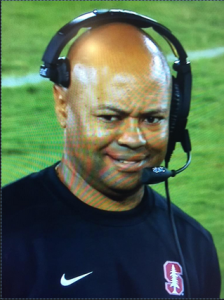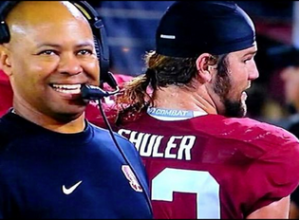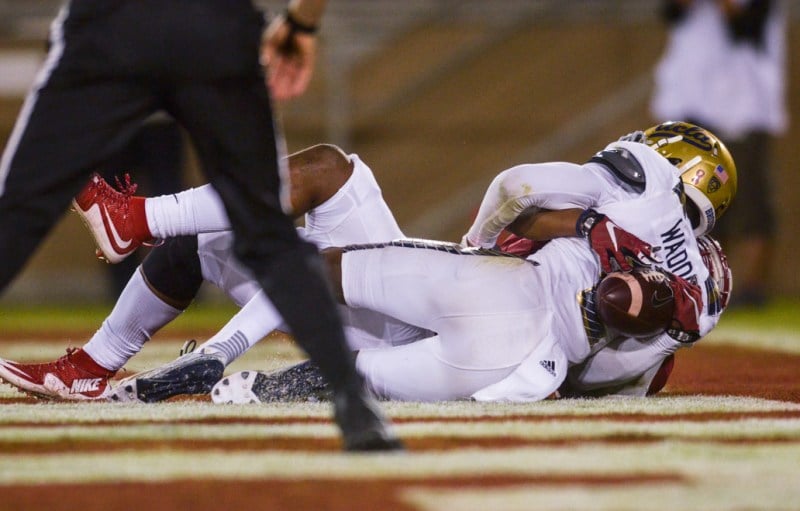“Did he catch that… pinned against a defender’s back? That is utterly incredible!”
Watch out, Odell Beckham, Jr. There’s a new “catch of the century” in town, and it belongs to Stanford junior Francis Owusu. His remarkable, behind-a-defender’s-back catch off of a double reverse from the Wildcat trended nationally on Twitter, found ESPN announcer Joe Tessitore in a stunned moment of candor and shocked a nation on primetime Thursday night television.
“I saw the catch and didn’t know what to do,” said sophomore running back Christian McCaffrey. “Sprinted to the sideline and just sat down. And I was at a loss for words, kind of like I am now. I couldn’t believe that. That was one of the most amazing things I’ve ever seen in my life.”
“That was probably the greatest play I’ve ever been a part of,” said fifth-year senior quarterback Kevin Hogan, who heaved the ball downfield for Owusu to grab.
In fact, the least hyperbole-filled account of the jaw-dropping play probably belonged to Owusu himself, who didn’t even seem the least bit energized in postgame interviews — if you hadn’t seen the play, you wouldn’t have been able to tell whether he’d made the catch of the century or he’d bought a new pair of shoes.
“I saw it for a little bit, and then from there, I just felt the ball after that,” he deadpanned. “Didn’t really see it and then squeezed as hard as I can when I felt it.”
“[The safeties] were playing a little low and I was able to sneak past them,” he added. “And then I just… caught a ball.”
Yeah, that’s one way to put it.
basically pic.twitter.com/pq1w4X8B2G
— Holly Anderson (@HollyAnderson) October 16, 2015
There was not a soul in the stadium that expected that pass to be caught, including head coach David Shaw, who didn’t even watch the end of the play, assuming that it was going to be incomplete and a pass interference. He was already looking down at his play sheet, ready to call his next play, when he heard the roar of the crowd and his players going nuts around him.
“I was looking at my call sheet for the next call because I thought it was incomplete, and the guys were telling me that he caught it,” Shaw said. “And I said he didn’t catch it, it’s incomplete. And then it showed up on the board and I — apparently, I’ve been told that my facial expression was on TV for many times, and I still feel that way right now.”

What made the catch even more special for most Stanford supporters, though, wasn’t just the catch itself, but the development of the play leading into it.
It was actually one of three Stanford touchdowns on Thursday night scored out of the Wildcat, which has drawn lots of criticism in recent years but has been the gift that has kept on giving for the Cardinal this season.
It’s not unusual for Stanford to leave Hogan on the field for the Wildcat split out wide, but 99 times out of 100, he’s essentially a non-factor, drawing one of the defensive backs towards his side of the field so that Stanford doesn’t have an easy completion to an uncovered receiver. (“Just staying out of the way,” as he put it a few weeks ago.)
But this past week — perhaps with the extra time due to the bye week — the coaches brought the reverse pass out of hibernation and the team actually ran it in drills several times throughout the week to get comfortable with it in case a situation arose in which it could use it on Thursday against UCLA.

The Cardinal used the Wildcat aggressively in the first half, including two consecutive Wildcat runs in the red zone at one point to set up Hogan’s touchdown pass to Devon Cajuste. And during halftime, even with the Cardinal up 35-17, the coaches decided that they liked what they were seeing from UCLA’s safeties and told Owusu that they were going to dial up the reverse pass.
“We practiced that a couple of times over the week, and it worked,” Owusu said. “Coach said during halftime that they were going to call it, and we ended up doing it.”
“Just the way that the UCLA safeties had to come up and support the run, we thought that we could get them to bite and get behind them and Francis did the rest,” Hogan added. “Just made a heck of a catch.”
McCaffrey took the snap and handed it off to a sweeping Bryce Love, who pitched it to Hogan, who was reversing field from his wide receiver position. Hogan took a few steps back to the middle of the field, set his feet, and let loose. He actually had to take a little off the ball because the play developed too slowly and he didn’t want to throw it out of the back of the end zone, setting the stage for Owusu’s heroics.
For as crazy as the Cardinal’s Wildcat shenanigans have seemed, though, this play is far from unique in the Cardinal’s recent history.
The last time Stanford ran this exact variant of the play was in the triple-overtime game at USC in 2011, when the Cardinal — down 20-17 in the third quarter — brought the energy back into their offense by running the play for a 62-yard gain.
On that play, the Wildcat quarterback was Tyler Gaffney, the sweep man was Anthony Wilkerson, the wide-receiver-quarterback was Andrew Luck and the deep bomb went to Ty Montgomery streaking down the field. That catch was a lot less eventful because of Stanford’s field position, which allowed Luck to air the ball out and for Montgomery to keep running to the ball, instead of going back for it like Owusu did.
Schematically, it was a very similar play — and executed without a hitch, though one could argue that the “hitches” in Stanford’s Owusu catch were what allowed for the catch to be once-in-a-generation in the first place.
The other instance of Wildcat trickery in the Shaw era came on one of the biggest stages of the sport: The 2013 Rose Bowl between Stanford and Wisconsin.
In that game, with Stanford moving the ball effectively on Wisconsin on its first drive of the game, Shaw emptied his playbook by dialing up the Wildcat reverse pass and a jet sweep to Kelsey Young on back-to-back plays for an explosive touchdown drive.
In that case, though, Wisconsin had less of a reason to be tipped off to the pass because it wasn’t the quarterback (Hogan) out there that delivered the pass; instead, it was wide receiver Drew Terrell, who had established himself as a passing savant of sorts during his time at Stanford. (He was also the quarterback on the Andrew Luck one-handed catch in 2011).
After Stepfan Taylor got Stanford a first down near midfield, Stanford sent out the Wildcat, with Wilkerson as the quarterback, Young as the sweep man, Terrell as the wide-receiver-quarterback and Jamal-Rashad Patterson as the recipient of the pass. Although it was no Owusu grab for sure, Patterson’s snag itself was something to behold, too.
The base idea of the Wildcat is that Stanford can devote one more blocker to the point of attack, which is advantageous in its running game and something that, as Shaw pointed out after the UCLA game, has made the Wildcat incredibly efficient for the Cardinal. And once in a very long while, when everything is going right, it can also offer some crazy trick plays as well.
Who ever said that David Shaw was bland?
Contact Do-Hyoung Park at dhpark ‘at’ stanford.edu.
